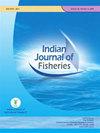印度洋东北部热带地区黄鳍金枪鱼的相对丰度
IF 0.3
4区 农林科学
Q4 FISHERIES
引用次数: 1
摘要
印度洋东北部的热带地区历来是黄鳍金枪鱼的主要渔场(Bonnatere,1788)。然而,在过去二十年中,日本或台湾船队的低投入导致了黄鳍金枪鱼相对丰度估计的一些不确定性,这影响了当前种群分析对已经减少的种群的稳健性。因此,这项研究是利用2006-2021年印尼科学观察员的数据来弥补研究差距的,该数据涵盖了印度洋东北部。采用德尔塔对数正态模型来拟合数据,单位努力捕获量作为响应变量,年、季度、月相、纬度和经度作为已知协变量。使用基于Akaike信息准则(AIC)(Akaike,1974)、贝叶斯信息准则(BIC)(Schwarz,1978)和确定系数值(R2)的反向方法选择最优模型。总的来说,黄鳍金枪鱼的相对丰度仍然处于非常低的水平,在头十年有明显下降的趋势,随后在过去三年略有恢复的迹象。然而,这种增长趋势被不确定性所掩盖,这些不确定性可能是由于自然变化和某些年份的低覆盖率造成的。尽管这些系列被认为很短,但它成功地描绘了印度洋东北部热带地区黄鳍金枪鱼丰度的动态,这对于进行更有力的捕捞策略评估至关重要。关键词:种群减少,渔业独立数据,高度洄游,相对丰度,科学观察者本文章由计算机程序翻译,如有差异,请以英文原文为准。
Relative abundance of yellowfin tuna Thunnus albacares (Bonnaterre, 1788) in the tropical area of the north-eastern Indian Ocean
The tropical area of the north-eastern Indian Ocean has historically been a prominent fishing ground for yellowfin tunaThunnus albacares (Bonnaterre, 1788). However, low effort from either Japanese or Taiwanese fleet in the last two decadeshas driven some uncertainties in relative abundance estimates of yellowfin tuna, which affects the robustness of the currentstock analysis for an already declined population. Hence this study was carried out to bridge the research gap by utilising theIndonesian scientific observer data from 2006-2021, which covers the north-eastern Indian Ocean. A delta-lognormal modelwas adopted to fit the data, with the catch per unit effort as the response variable and year, quarter, moon phase, latitudeand longitude as known covariates. The optimal model was chosen using a backward method based on Akaike InformationCriterion (AIC) (Akaike, 1974), Bayesian Information Criterion (BIC) (Schwarz, 1978) and the values of the coefficientof determination (R2). In general, the relative abundance of yellowfin tuna remained at a very low level, with an apparentdeclining trend in the first decade, followed by a slight sign of recovery in the past three years. However, the increasing trendwas overshadowed by uncertainties, likely caused due to natural variation and low coverage in some years. Although theseries was considered short, it managed to picture the dynamics of the abundance of yellowfin tuna in the tropical area of thenorth-eastern Indian Ocean, which is essential for conducting a more robust harvest strategy evaluation.
Keywords: Declining stock, Fisheries-independent data, Highly migratory, Relative abundance, Scientific observer
求助全文
通过发布文献求助,成功后即可免费获取论文全文。
去求助
来源期刊

Indian Journal of Fisheries
FISHERIES-
CiteScore
0.90
自引率
20.00%
发文量
0
审稿时长
6-12 weeks
期刊介绍:
Indian Journal of Fisheries is published quarterly by the Indian Council of Agricultural Research (ICAR), New Delhi. Original contributions in the field of Fish and fisheries science are considered for publication in the Journal. The material submitted must be unpublished and not under consideration for publication elsewhere.
Papers based on research which kills or damages any species, regarded as thratened/ endangered by IUCN crieteria or is as such listed in the Red Data Book appropriate to the geographic area concerned, will not be accepted by the Journal, unless the work has clear conservation objectives.
 求助内容:
求助内容: 应助结果提醒方式:
应助结果提醒方式:


